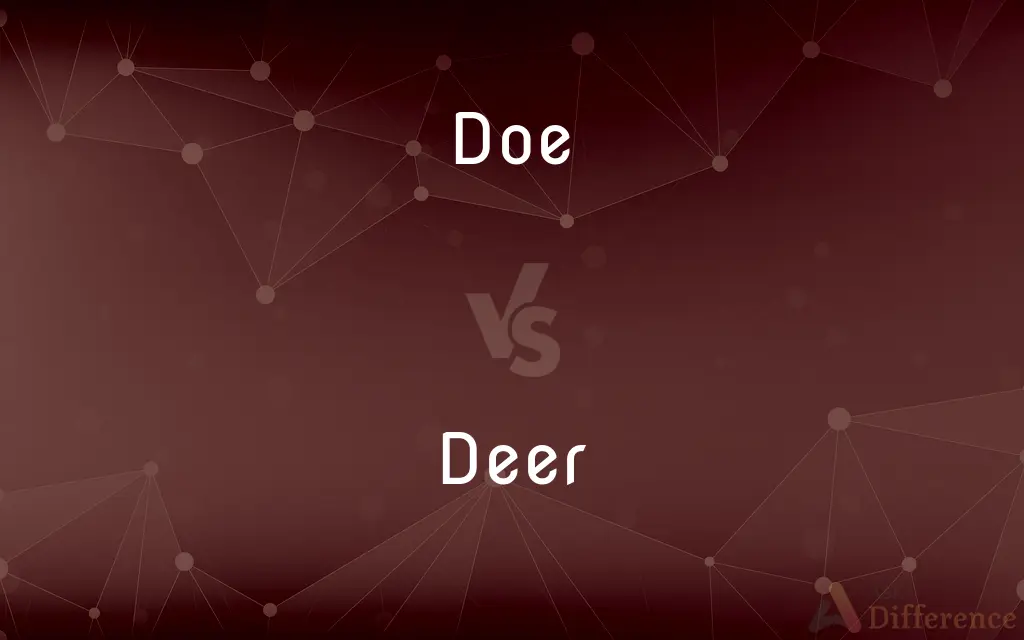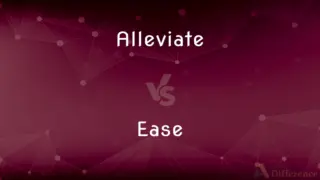Doe vs. Deer — What's the Difference?
By Fiza Rafique & Urooj Arif — Updated on March 27, 2024
A doe is a female deer, while "deer" refers to the animal species as a whole, encompassing both male and female individuals.

Difference Between Doe and Deer
Table of Contents
ADVERTISEMENT
Key Differences
A doe specifically refers to the female of the deer species, known for not having antlers (with few exceptions, like the female reindeer). These animals play a crucial role in the reproduction and nurturing of fawns. On the other hand, the term "deer" encompasses the entire species, which includes does, bucks (males), and fawns (juveniles). This broader term is used when referring to the species in general, without specifying gender or age.
Doe is often used in contexts emphasizing the behavior, physiology, or specific roles of female deer, such as maternal care or seasonal behavior patterns. Deer, as a collective term, is utilized in discussions regarding the species' habits, habitats, conservation status, and interactions with their ecosystems. This distinction is important in wildlife management, hunting regulations, and ecological research.
In hunting and wildlife management, does are sometimes the focus of specific regulations aimed at controlling populations and ensuring healthy herd dynamics. Regulations may dictate specific seasons or limits for harvesting does, unlike general deer hunting regulations, which might have broader or differently focused rules.
The life cycle and behavior of a doe can differ significantly from that of a buck, beyond the obvious reproductive roles. Does are responsible for gestation and rearing of fawns, influencing their movements, habitat preferences, and social structures within deer populations. Conversely, "deer" as a term does not imply any particular behavior related to reproduction but rather refers to species-wide characteristics and behaviors.
Understanding the difference between doe and deer is also essential for non-hunting contexts, such as wildlife observation, photography, and conservation efforts. Observers may seek to identify does for their unique behaviors or roles within the deer community, while general deer observation encompasses all members of the species, offering a broader understanding of deer ecology and social dynamics.
ADVERTISEMENT
Comparison Chart
Definition
A female deer, typically without antlers.
The entire species of deer, including males, females, and juveniles.
Role in Reproduction
Direct involvement in breeding and nurturing offspring.
Refers to both genders' roles in the species' reproduction.
Antlers
Generally lacks antlers, except in species like reindeer.
Includes both antlered (usually males) and antlerless individuals.
Usage
Specific to discussions about female deer.
General term for the species, used in broad discussions.
Management & Hunting
Subject to specific regulations focusing on population control and herd health.
Covered by broader hunting regulations and conservation strategies.
Compare with Definitions
Doe
A female deer, especially one of a species where the males typically have antlers.
The doe grazed quietly at the edge of the forest.
Deer
A term for the hoofed ruminant animals belonging to the family Cervidae.
Deer are known for their graceful movements and majestic antlers.
Doe
Used to refer to the gentle and nurturing nature of female deer.
A doe and her fawn were spotted near the creek at dawn.
Deer
Deer species vary widely in size, habitat, and behavior.
The white-tailed deer is a common sight in North American woodlands.
Doe
Symbolically, does often represent femininity and grace in various cultures.
The doe in the story symbolized motherhood and protection.
Deer
In many cultures, deer symbolize various attributes such as agility, freedom, and spiritual authority.
The deer is an important totem in many indigenous cultures.
Doe
Does play a crucial role in the deer life cycle through gestation and rearing of fawns.
The doe isolated herself from the herd to give birth to her fawn.
Deer
Conservation efforts for deer focus on habitat preservation, population control, and protection from poaching.
Conservationists have been working to protect the habitat of the endangered Key deer.
Doe
In wildlife management, does are often targeted for specific population control measures.
The wildlife reserve implemented a doe-only hunting season to manage the deer population.
Deer
Deer are subject to various environmental and human-induced pressures, affecting their populations globally.
Urban expansion has significantly reduced deer habitats, leading to increased human-deer conflicts.
Doe
A female deer, especially a female roe, fallow deer, or reindeer.
Deer
Deer or true deer are hoofed ruminant mammals forming the family Cervidae. The two main groups of deer are the Cervinae, including the muntjac, the elk (wapiti), the red deer, the fallow deer, and the chital; and the Capreolinae, including the reindeer (caribou), the roe deer, the mule deer, and the moose.
Doe
A female deer.
Deer
Any of various hoofed ruminant mammals of the family Cervidae, characteristically having deciduous antlers borne chiefly by the males. The deer family includes the white-tailed deer, elk, moose, and caribou.
Doe
The female of various other mammals, such as antelopes, kangaroos, mice, or rabbits.
Deer
A ruminant mammal with antlers and hooves of the family Cervidae, or one of several similar animals from related families of the order Artiodactyla.
Doe
A female deer; also used of similar animals such as antelope, (less commonly goat as nanny is also used).
Deer
(in particular) One of the smaller animals of this family, distinguished from a moose or elk
I wrecked my car after a deer ran across the road.
Doe
A female rabbit.
Deer
The meat of such an animal; venison.
Oh, I've never had deer before.
Doe
A female hare.
Deer
Any animal, especially a quadrupedal mammal as opposed to a bird, fish, etc.
Doe
A female squirrel.
Deer
Any animal; especially, a wild animal.
Mice and rats, and such small deer.
The camel, that great deer.
Doe
A female kangaroo.
Deer
A ruminant of the genus Cervus, of many species, and of related genera of the family Cervidæ. The males, and in some species the females, have solid antlers, often much branched, which are shed annually. Their flesh, for which they are hunted, is called venison.
Doe
A female deer or antelope; specifically, the female of the fallow deer, of which the male is called a buck. Also applied to the female of other animals, as the rabbit. See the Note under Buck.
Deer
Distinguished from Bovidae by the male's having solid deciduous antlers
Doe
The federal department responsible for maintaining a national energy policy of the United States; created in 1977
Doe
Mature female of mammals of which the male is called `buck'
Common Curiosities
Are there any deer species where females have antlers?
Yes, in some species like the reindeer (caribou), both males and females can have antlers, although female antlers are usually smaller.
How do hunters differentiate between a doe and a buck?
Hunters typically differentiate based on physical characteristics; bucks usually have antlers, whereas does do not.
Can all deer species be referred to as "deer"?
Yes, "deer" is a collective term that refers to all members of the deer family, encompassing various species worldwide.
How do deer adapt to different habitats?
Deer adapt through variations in diet, behavior, and physical characteristics, enabling them to inhabit a wide range of environments.
What challenges do deer populations face?
Challenges include habitat loss, hunting, disease, and predation, which can all impact population dynamics.
What distinguishes a doe from other deer?
A doe is a female deer, often characterized by the absence of antlers, which distinguishes her from male deer, or bucks.
Why are does important in deer populations?
Does play a crucial role in the reproduction and nurturing of fawns, directly influencing the health and growth of deer populations.
Do does and bucks have different behaviors?
Yes, their behaviors can differ significantly, especially due to their roles in reproduction and rearing of young.
What is the significance of doe management in wildlife conservation?
Effective doe management helps maintain balanced deer populations, ensuring ecological health and reducing human-wildlife conflicts.
Why are deer considered important in many cultures?
Deer symbolize various traits such as agility, grace, and spiritual significance, making them important in mythologies and folklore.
How do environmental factors affect deer?
Environmental factors such as climate, food availability, and habitat quality directly impact deer health and behavior.
What role do does play in the deer social structure?
Does often form maternal groups and play a central role in rearing fawns, influencing social structures within deer populations.
Can doe-only hunting seasons affect deer population dynamics?
Yes, selectively harvesting does can be a management tool to control or adjust deer population sizes and structures.
How do conservation efforts benefit deer?
Conservation efforts aim to protect habitats, regulate hunting, and mitigate other threats to ensure sustainable deer populations.
Share Your Discovery

Previous Comparison
Warehouse vs. Store
Next Comparison
Alleviate vs. EaseAuthor Spotlight
Written by
Fiza RafiqueFiza Rafique is a skilled content writer at AskDifference.com, where she meticulously refines and enhances written pieces. Drawing from her vast editorial expertise, Fiza ensures clarity, accuracy, and precision in every article. Passionate about language, she continually seeks to elevate the quality of content for readers worldwide.
Co-written by
Urooj ArifUrooj is a skilled content writer at Ask Difference, known for her exceptional ability to simplify complex topics into engaging and informative content. With a passion for research and a flair for clear, concise writing, she consistently delivers articles that resonate with our diverse audience.
















































